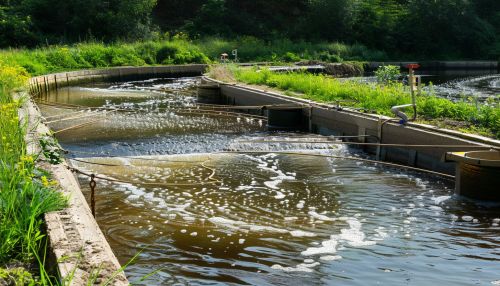Trickling filter
Overview
A Trickling filter is a type of wastewater treatment system that utilizes a bed of rocks, gravel, slag, peat moss, or plastic media to facilitate the growth of microbial films. These films, also known as biofilms, degrade organic matter present in the wastewater. The trickling filter is one of the oldest and most reliable forms of wastewater treatment, and it is still widely used in various parts of the world today.


History
The trickling filter was first developed in the late 19th century as a method to treat sewage. The first trickling filter was built in England in 1893, and the technology quickly spread to other parts of the world. In the United States, the first trickling filter was built in Madison, Wisconsin in 1901. Over the years, the design and operation of trickling filters have evolved significantly, but the basic principle of biological treatment using a bed of media has remained the same.
Design and Operation
A typical trickling filter consists of a circular or rectangular tank filled with a bed of media. The media is typically 1-2 meters deep, but can be as deep as 2.5 meters in some designs. The wastewater is distributed over the surface of the media by a rotating arm, which allows the water to trickle down through the media. As the water trickles down, it comes into contact with the biofilm on the surface of the media, where organic matter is degraded by the microorganisms.
The design of the trickling filter can vary depending on the specific requirements of the wastewater treatment process. Some designs use a single stage trickling filter, while others use a two-stage or even three-stage process. In a two-stage trickling filter, the wastewater is first treated in a primary trickling filter, and then the effluent from the primary filter is treated in a secondary trickling filter.
Biofilm Development
The biofilm in a trickling filter is a complex community of microorganisms, including bacteria, fungi, and protozoa. These microorganisms form a slimy layer on the surface of the media, where they feed on the organic matter in the wastewater. The development of the biofilm is a critical aspect of the trickling filter process, as it is the biofilm that performs the actual treatment of the wastewater.
The development of the biofilm begins with the attachment of individual microorganisms to the surface of the media. These microorganisms multiply and form a layer of cells, which is then colonized by other types of microorganisms. Over time, the biofilm grows in thickness and complexity, forming a diverse microbial community.
Performance and Efficiency
The performance of a trickling filter is influenced by a variety of factors, including the quality of the wastewater, the design of the filter, and the operation of the system. In general, trickling filters are capable of achieving high levels of organic matter removal, with efficiencies typically ranging from 85% to 95%.
The efficiency of a trickling filter can be improved by optimizing the design and operation of the system. For example, the distribution of the wastewater over the surface of the media is a critical factor in the performance of the filter. If the wastewater is not evenly distributed, it can lead to uneven biofilm development and reduced treatment efficiency.
Advantages and Disadvantages
Trickling filters offer several advantages over other types of wastewater treatment systems. They are relatively simple to operate and maintain, and they require less energy than activated sludge systems. They are also capable of handling variable loads and shock loads, making them suitable for a wide range of applications.
However, trickling filters also have some disadvantages. They require a large land area, and they can produce odors if not properly managed. In addition, the performance of trickling filters can be affected by temperature, as the activity of the microorganisms in the biofilm is temperature-dependent.
Future Developments
While trickling filters are a mature technology, there is still ongoing research and development in this area. Future developments may include the use of new types of media, improvements in the design and operation of the system, and the integration of trickling filters with other wastewater treatment processes.
See Also
Rotating biological contactor Activated sludge Biofilm
